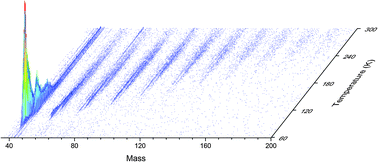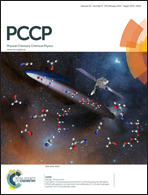Infrared and reflectron time-of-flight mass spectroscopic analysis of methane (CH4)–carbon monoxide (CO) ices exposed to ionization radiation – toward the formation of carbonyl-bearing molecules in extraterrestrial ices†
Abstract
Ice mixtures of methane and carbon monoxide were exposed to ionizing radiation in the form of energetic electrons at 5.5 K to investigate the formation of carbonyl bearing molecules in extraterrestrial ices. The radiation induced chemical processing of the mixed ices along with their isotopically labeled counterparts was probed online and in situ via infrared spectroscopy (solid state) aided with reflectron time-of-flight mass spectrometry (ReTOFMS) coupled to single photon photoionization (PI) at 10.49 eV (gas phase). Deconvolution of the carbonyl absorption feature centered at 1727 cm−1 in the processed ices and subsequent kinetic fitting to the temporal growth of the newly formed species suggests the formation of acetaldehyde (CH3CHO) together with four key classes of carbonyl-bearing molecules: (i) alkyl aldehydes, (ii) alkyl ketones, (iii) α,β-unsaturated ketones/aldehydes and (iv) α,β,γ,δ-unsaturated ketones/α,β-dicarbonyl compounds in keto-enol form. The mechanistical studies indicate that acetaldehyde acts as the key building block of higher aldehydes (i) and ketones (ii) with unsaturated ketones/aldehydes (iii) and/or α,β-dicarbonyl compounds (iv) formed from the latter. Upon sublimation of the newly synthesized molecules, ReTOFMS together with isotopic shifts of the mass-to-charge ratios was exploited to identify eleven product classes containing molecules with up to six carbon atoms, which can be formally derived from C1–C5 hydrocarbons incorporating up to three carbon monoxide building blocks. The classes are (i) saturated aldehydes/ketones, (ii) unsaturated aldehydes/ketones, (iii) doubly unsaturated aldehydes/ketones, (iv) saturated dicarbonyls (aldehydes/ketones), (v) unsaturated dicarbonyls (aldehydes/ketones), (vi) saturated tricarbonyls (aldehydes/ketones), molecules containing (vii) one carbonyl – one alcohol (viii), two carbonyls – one alcohol, (ix) one carbonyl – two alcohol groups along with (x) alcohols and (xi) diols. Reaction pathways to synthesize these classes were derived as well. The present experiments provide clear evidence for the formation of key organic molecules – acetaldehyde, acetone, and potentially vinylalcohol – which are among the 15 carbonyl containing organic molecules detected in the interstellar medium. Despite numerous previous experimental investigations probing the effect of ionizing radiation on simple astrophysical ice representatives, our results suggest that more complex organic molecules can be formed in extraterrestrial ices than previously suggested. An outlook on further identification of individual isomers is also presented.

- This article is part of the themed collection: Astrochemistry

 Please wait while we load your content...
Please wait while we load your content...